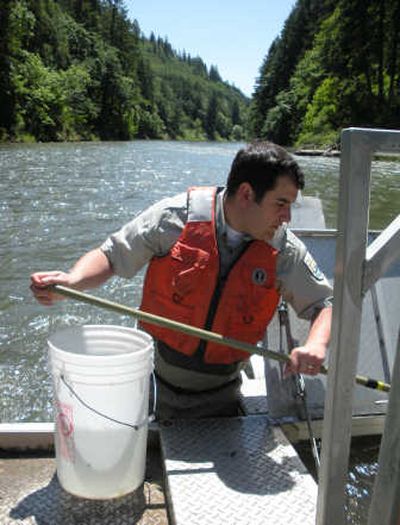Salmon rebound is possible

UNDERWOOD, Wash. – In a little over a year, the sparkling emerald water of the lower White Salmon River will turn brown with a torrent of mud unleashed by the removal of Condit Dam.
The mountain of sediment that has accumulated against the back side of Condit over the past 95 years will bury the lower White Salmon until the river’s natural flow can clear it away in two to five years. Before that happens, federal researchers wanted to get a better sense of any wild salmon spawning in the three miles between the dam and the White Salmon’s confluence with the Columbia River.
Two years ago, they installed a rotary screw trap to scoop salmon fry skimming along the river’s surface after emerging from the river’s gravelly bottom in the spring.
They found fish by the thousands.
“A lot of people thought we wouldn’t catch anything,” said Rod Engle, a biologist with the U.S. Fish & Wildlife Service.
Even more revealing, subsequent genetic tests over each of the past three years show one of the two distinct wild populations identified in the river is closely related to tule fall chinook produced by the Spring Creek National Fish Hatchery on the Columbia just downriver from the mouth of the White Salmon. The hatchery traces its roots to 1901, when it was built to offset the loss of wild salmon from overfishing and, later, mitigate for the natural habitat lost to a flurry of dam-building on tributaries such as the Yakima, Sandy and White Salmon rivers.
Today, the hatchery releases some 15 million tule fall chinook each spring, ultimately to be caught by commercial, sport and tribal fishermen on the river and in the ocean.
Now, with PacifiCorp planning to remove Condit Dam rather than meet a new federal requirement to retrofit it with expensive fish ladders, the new research suggests a free-flowing White Salmon will be primed for recolonization by descendants of the same native fish culled by hatchery managers more than a century ago.
“In essence, we’ve been keeping these fish in trust,” Engle said. “This might be an opportunity for them to get a foothold again.”
The Fish & Wildlife Service and U.S. Geological Survey are joining to conduct the three-year, $130,000 study.
PacifiCorp spokeswoman Jan Mitchell said the company is preparing to remove the dam in October 2009. Condit generates a relatively meager amount of energy, about 14 megawatts, compared to the 1,087 megawatts at Bonneville Dam, and the utility has been operating on a year-by-year federal license since agreeing in 1999 with tribal and conservation groups to remove it.
No one doubts wild-spawning fish will encounter a bleak environment in the lower three miles of the White Salmon in the first few years after Condit is removed. In an ironic twist, the hatchery may help to jump-start a wild run.
One fishery geneticist said the research suggests a strong possibility that the White Salmon can be successfully recolonized by tule fall chinook straying beyond their birthplace in the concrete raceways of the Spring Creek hatchery.
“Even though the individuals returning there will suffer high mortality, as soon as there is good habitat there, you would expect fish from the Spring Creek hatchery to be recolonizing that area,” said Christian Smith, fishery geneticist with the Fish & Wildlife Service’s Abernathy Fish Technology Center in Longview, Wash.
It’s less certain whether the fish will be able to propagate generation after generation without the hatchery.
That’s because scientists suspect the wild population spawning in the White Salmon already comprises mainly first- or second-generation strays from the Spring Creek hatchery.
Studies have shown that fish raised in hatcheries fail to survive as well as their wild, native cousins.
“Like domestic animals, they become very different from wild populations,” Smith said.
Biologists worry that fish raised in hatcheries gradually lose the characteristics they developed over generations to adapt to specific rivers and streams, thus threatening their long-term survival. In the Columbia River Basin, overfishing and dramatic habitat changes over the past century have driven the number of returning spawners from as many as 16 million to barely 3 million and more than 80 percent of those come from hatcheries.
Researchers are nonetheless enthusiastic about the possibility that wild coho, chinook and steelhead can be re-established in more than a dozen miles of relatively undisturbed habitat above the dam site.
The continuously spinning screw trap has collected about 5,000 inch-long fry this spring, which biologists figure is less than a twentieth of the salmon emerging for their trip down the White Salmon, past Bonneville Dam and on to the Pacific Ocean.
“We’re sampling a small amount of the river – very small,” Engle said. “I would say 5 percent is generous.”
Yet biologists said removing Condit Dam won’t magically turn the White Salmon into a wild fish producer anywhere near the magnitude of the free-flowing Hanford Reach on the Columbia, for example.
“It’s a river cut out of lava, basalt,” said Joe Skalicky, another service biologist based in Vancouver.
That means it doesn’t have much in the way of braided channels or floodplain where juvenile salmon can take refuge, find nutrients and rest for their long journey to the ocean.
Brady Allen, a biologist with the U.S. Geological Survey’s laboratory in Cook, Wash., added that even though the White Salmon is “no Cowlitz,” the river does have some habitat value due to the fact that its shoreline is relatively undeveloped.
A haven for whitewater rafting, the glacier-fed White Salmon may yet become equally attractive for oceangoing steelhead, coho and chinook salmon once it’s undammed.
“There’s an opportunity for a lot of salmon to get a foothold again,” Engle said.